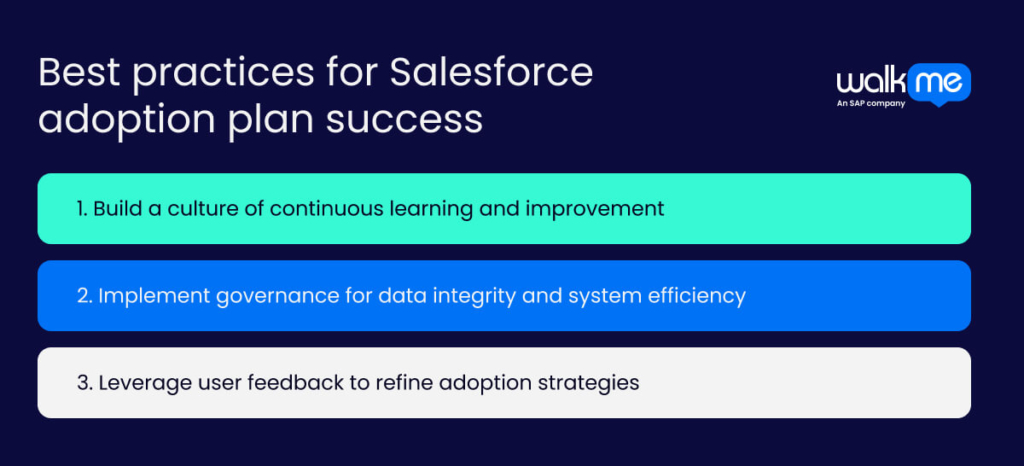Salesforce helps sales teams by providing customer data and reporting tools that improve employee productivity and training. Reps can manage time better, follow up on leads, and strengthen the customer experience. But, simply having Salesforce won’t improve sales performance—teams must use it effectively.
Encouraging any form of digital adoption requires careful planning. Leaders should create a structured plan to integrate Salesforce into daily workflows, making tasks more efficient and boosting return on investment.
This article offers a step-by-step guide to building a Salesforce adoption plan and highlights best practices for ensuring companies get the most value from Salesforce.
What is a Salesforce adoption plan?
A Salesforce adoption plan is a continuous roadmap that helps a business integrate Salesforce into the daily work of their employees. It ensures they have the proper knowledge and support to complete tasks, achieve goals, and make the most of the system.
Good adoption planning can also shape how well admins and developers have customized Salesforce to fit the company’s needs.
While user experience (UX) and user interface (UI) play a role, successful adoption depends on three key areas. First is employee onboarding, which determines how easily new users adjust to Salesforce. Some adapt quickly, while others need more guidance.
Next is tracking, which involves measuring user activity through data and feedback to understand engagement. Lastly, optimization focuses on making system improvements to boost efficiency and productivity.
By focusing on these areas, companies can improve user adoption, streamline workflows, and maximize their Salesforce investment. In addition, a strong Salesforce adoption plan leads to better collaboration and more effective business processes.
How to create a Salesforce adoption plan

A structured Salesforce adoption plan helps teams work together and build stronger customer relationships. Over time, it can also lead to more business transformation through other forms of tech.
Here are the steps to create a successful plan:
1. Assess business needs and user requirements
Understanding your end users is the first step in building a successful Salesforce adoption strategy. To help your team use Salesforce effectively, you must learn their specific needs and how they interact with the CRM. By understanding these details, you can provide the right tools and knowledge to help your team perform better, driving overall success.
Introducing a new system can be overwhelming, so create a collaborative focus group. Listen to your team’s concerns about how Salesforce might impact their daily tasks. This will help build trust and support them during the transition.
Create a group with key users from each department and role to gain insights into their pain points and needs. Additionally, a survey will be sent out to all users to gather feedback on how Salesforce can best fit their workflows. This feedback helps you build a personalized adoption strategy and highlight the features that will benefit each team.
2. Secure executive buy-in and leadership support
To gain leadership support for Salesforce adoption, explain how the platform will help achieve business goals, such as increasing sales, improving customer satisfaction, and boosting efficiency. Leadership will more likely support the adoption when they understand how Salesforce directly aligns with the company’s broader objectives.
Provide examples of how Salesforce can streamline workflows, cut costs, and generate more revenue. Showing the platform’s return on investment (ROI) will help make a stronger case for adoption.
Build a compelling argument demonstrating how Salesforce can solve specific business challenges and seize new opportunities. When leadership actively uses Salesforce and engages with its features, they set an example for the rest of the team. Their enthusiasm and commitment will inspire others to adopt Salesforce and leverage its full potential.
3. Define clear adoption goals and success metrics
Before adopting Salesforce, identify the business problems or opportunities it can solve. Define your strategic goals to ensure Salesforce supports key objectives like streamlining processes.
Set SMART goals to guide your adoption. Clearly state what you want to achieve with Salesforce, and make sure the goals are measurable with targets you can track and evaluate. Ensure the goals are realistic within the set timeframe and relevant to your business strategy. Lastly, set a deadline for achieving these goals.
Track key performance indicators (KPIs) to measure success. Go beyond login counts by monitoring metrics like the number of opportunities created, reports run, and data quality. Focus on user engagement by checking activity levels, feature usage, and training effectiveness. Also, the business impact can be measured by tracking how Salesforce influences pipeline development and revenue generation.
4. Build a phased rollout strategy
Implementing Salesforce takes careful planning, so break the process into stages to avoid errors and confusion. Start with a pilot program by selecting a small group of users to adopt Salesforce first. This approach lets you identify and fix issues before they create frustration or resistance.
Gather feedback from these users to understand challenges and improve Salesforce training. Ask them about their experience, identify pain points, and determine which training methods work best. Observing a small group in action helps uncover problems in setup, adoption, and workflow integration. Use this insight to refine your strategy and improve the overall rollout. By testing and adjusting early, you can ensure a smoother transition for the rest of the organization.
5. Develop a structured training program
Leaders can forget about training and change management during a Salesforce project. To ensure strong user adoption, create a clear plan with simple, step-by-step training. Break training into smaller sessions to prevent overwhelming your team. Start with basic skills like navigating the platform, then introduce more advanced tasks based on team needs.
Encourage users to explore Trailhead for additional learning or set up a custom learning path. Use Salesforce in-app Guidance to provide on-screen tips and step-by-step instructions. These tools help users learn as they work, making the process smoother.
Improve employee engagement with fun activities and incentives. Host launch events, offer rewards, and recognize employees who quickly adapt to Salesforce. When leaders actively support training and encourage participation, teams feel more confident using the platform. A well-planned approach makes the transition easier and helps employees get the most out of Salesforce.
6. Optimize the Salesforce user experience
To improve the Salesforce user experience, tailor it to your business needs. Adjust page layouts to display only essential fields, helping users find information faster. Organize the App Launcher to highlight frequently used tools. Set default record views to show key details upfront, saving time. Use dynamic forms to adjust fields based on roles or record types, making data entry easier.
Next, automate repetitive tasks to increase efficiency. Create workflows and process automation to reduce manual work and errors. Integrate Salesforce with other tools your team relies on to streamline operations.
Then, maintain data quality by regularly cleaning and removing duplicates. Set up validation rules to ensure new entries meet company standards. Establish a schedule for ongoing data maintenance.
In addition, support users with proper training and resources. Provide clear instructions, encourage learning through Trailhead, and customize the Help Menu with relevant links. Gather user feedback to make continuous improvements.
Best practices for Salesforce adoption plan success

Salesforce adoption isn’t a linear process. Challenges will come up, and businesses need to adapt as things change. To make sure your team stays on track, you need practical tips that help with long-term success.
Here are the best practices to keep your Salesforce adoption plan effective over time:
1. Build a culture of continuous learning and improvement
Training only happens during new hire orientation, but it should continue over time.
Keep employee training simple. Break lessons into smaller, easy-to-follow sessions. Share quick tips through short videos and give users direct feedback on their strengths and areas for improvement. Encourage team members to join user groups, where they can learn best practices from their peers.
By providing regular training and support, you help users build confidence and improve their Salesforce skills. A steady learning approach ensures they stay engaged and get the most out of the platform.
2. Implement governance for data integrity and system efficiency
To maintain data integrity and system efficiency in Salesforce, clear governance policies must be defined. Identify the data that needs oversight and set goals for quality, security, and compliance. Establish standards for accuracy and assign data owners to ensure accountability. Restrict access to sensitive information and create rules for data retention.
Assign key roles to support governance. Data stewards maintain quality, while data owners oversee accuracy. A governance committee manages policies and decisions.
Use validation rules and automated workflows to enforce standards. Conduct digital audits, clean duplicate data, train users, and update policies to keep the system efficient and reliable.
3. Leverage user feedback to refine adoption strategies
To understand if users are happy with Salesforce, ask for their feedback through surveys, Chatter groups, or polls. Since Salesforce adoption takes time, check in regularly. Assign key leaders to gather input in different ways. Some employees may share concerns openly, while others prefer anonymous surveys. Offer both options to encourage honest feedback.
Discuss the responses with your team and find ways to address concerns. Show employees that their opinions matter by acting on their suggestions. When users feel heard and see improvements, they are more likely to use Salesforce well in their daily work.
Drive Salesforce adoption success with a long-term plan
Keeping Salesforce adoption strong requires continuous effort, planning, and communication. Teams succeed when they follow a clear plan and best practices. A well-structured approach helps employees use Salesforce effectively, driving business growth and improving customer experiences.
Show employees how Salesforce boosts productivity and automated reporting. Train them on its features and real benefits, ensuring they can adjust workflows and use the platform with confidence.
If employees resist change, phase out old systems, make key tasks Salesforce-exclusive, add gamification, and offer rewards. Engage leadership early, highlight business benefits, and gain their support to improve adoption rates.
FAQs
A Salesforce adoption plan helps businesses get the most value from their CRM. It ensures employees use its features well, leading to smoother workflows, better customer interactions, and more intelligent decisions.

